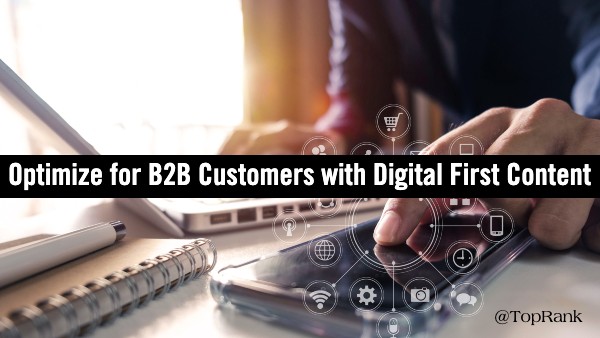Optimize for B2B Customers with Digital First Content Marketing

The evolution of B2B marketing has required companies to extend the transformations and pivots made during the pandemic to more permanent changes in marketing driven by evolving consumer preferences for information discovery, consumption and interaction. B2B marketing is evolved as a digital first practice and there’s no going back.
While most marketers understand it is simply not enough to rely on push marketing tactics and advertising, they still rely on these familiar and comfortable tactics.
Today’s business customers have more content choices in text, images, audio, video and interactive formats on more devices than ever. They expect more than just useful information from the brands they buy from.
In reaction to many of these changes in technology and an increased demand for information, many businesses have resolved to creating more content; more information to feed the insatiable appetite of the search and social web.
B2B marketers are responding to this need. Yearly research from Content Marketing Institute and MarketingProfs on Content Marketing consistently shows marketers are dedicated to using content in their marketing.
Unfortunately, simply creating more digital first content isn’t the answer. Competition is fierce for customer time and attention, raising the bar on content from simply providing information to delivering meaningful experiences. To stand out, engage and inspire action, todays businesses must engage in smarter, customer focused content marketing.
The shift from traditional digital marketing to a focus on integrated content experiences is requiring companies to rethink their approach. Making that transition requires an understanding some essential shifts:
Information Overload
According to a study from IBM, we’re creating 2.5 quintillion bytes daily— so much that 90% of the data in the world today has been created in the last two years alone.
Competition for attention has increased exponentially as brands evolve their publishing efforts and consumers are increasingly empowered to publish themselves. Blogs, social media sharing sites and networks are powered by brand and user generated content, all competing for time and attention.
Since most consumers are confronted by thousands of marketing messages every day, it’s essential that companies understand their customers and those who influence them. Using the right tools for everything from influencer discovery to topic optimization, brands can embark on a continuous effort to improve the performance of their content investment.
Data analysis and optimization tools will surface knowledge of specific customer segments and their pain points, goals and those who influence them. Armed with such insight, marketers will be better prepared to craft meaningful content marketing experiences to exceed customer expectations and pass the competition. Businesses must think beyond the mechanical and transition to a more meaningful approach to PR, search, social media and content marketing.
Disruption or Evolution?
Traditional publishing models have been significantly affected by these changes in technology and consumer information preferences. Print based publications are on the decline, newsroom resources and staff are shrinking and the roles of brand publishers and traditional media publishers are exchanging.
Driven by the Customer Journey
The diversity of information options and access through myriad devices empowers consumers with more decision making power before they ever act on an intent to purchase. The customer journey from awareness to consideration to purchase weaves it’s way through channels like search, news and social media in a dynamic path that is rarely linear and increasingly numb to push messaging.
Those companies that can attract and engage consumers earlier in the journey can establish a stronger brand connection and influence sales, despite a greater diversity of content and rising competition.
Architecting a content marketing plan across the customer buying cycle will enable marketers to plan content topics meaningful to each stage: awareness, interest, consideration, purchase, retention and advocacy. Content discovery, consumption and action at each stage can then be planned to optimize the customer experience.
Great content isn’t great until it’s discovered, consumed and acted on.
Re-thinking a content marketing strategy and it’s integration with search, social media and PR requires a solid definition of content marketing:
Content marketing is the planned creation, promotion and optimization of brand stories designed to create useful and meaningful experiences that attract, engage and inspire a target group of customers from awareness to purchase to advocacy.
With that definition, marketers can build a content marketing strategy that draws from both consumer insights and brand goals to create great content that is optimized for discovery, engagement and conversion towards business goals
Next steps and key questions:
- What business goals could be solved by more useful and meaningful content?
- Who are the target audiences your business needs to connect with? What do they care about? What are their goals?
- Develop an editorial calendar that takes into account how each target customer segment discovers, consumes and acts on information needed during their buying cycle
- Build search, social media and media optimization best practices into your content planning and promotion efforts.
- Continuously analyze key performance indicators and business outcomes to optimize the performance of your content marketing investment

